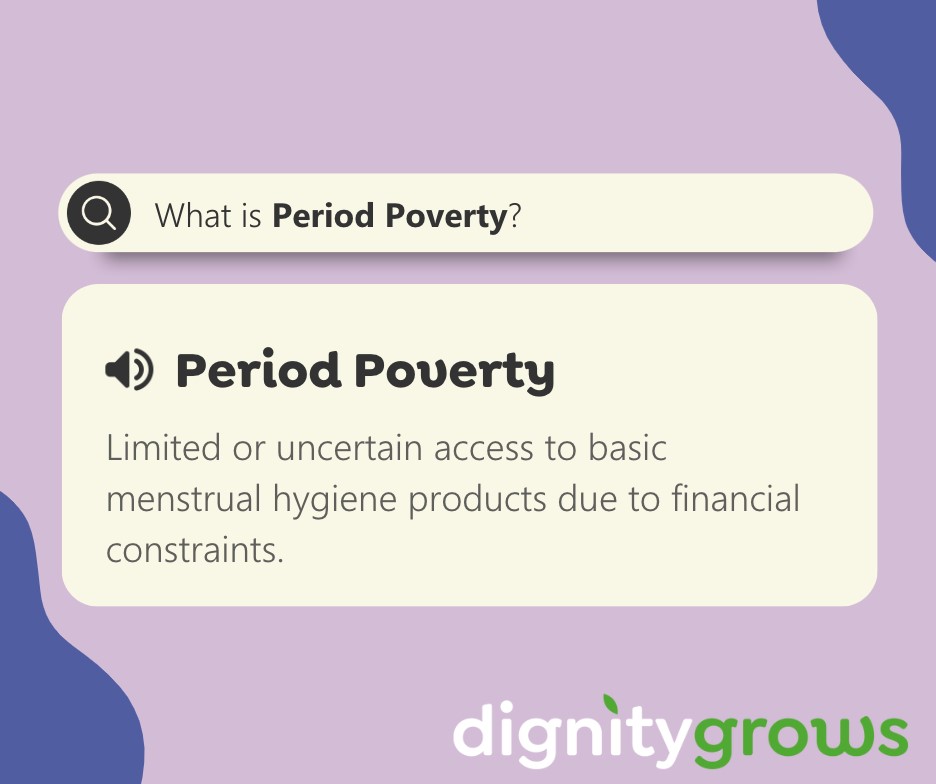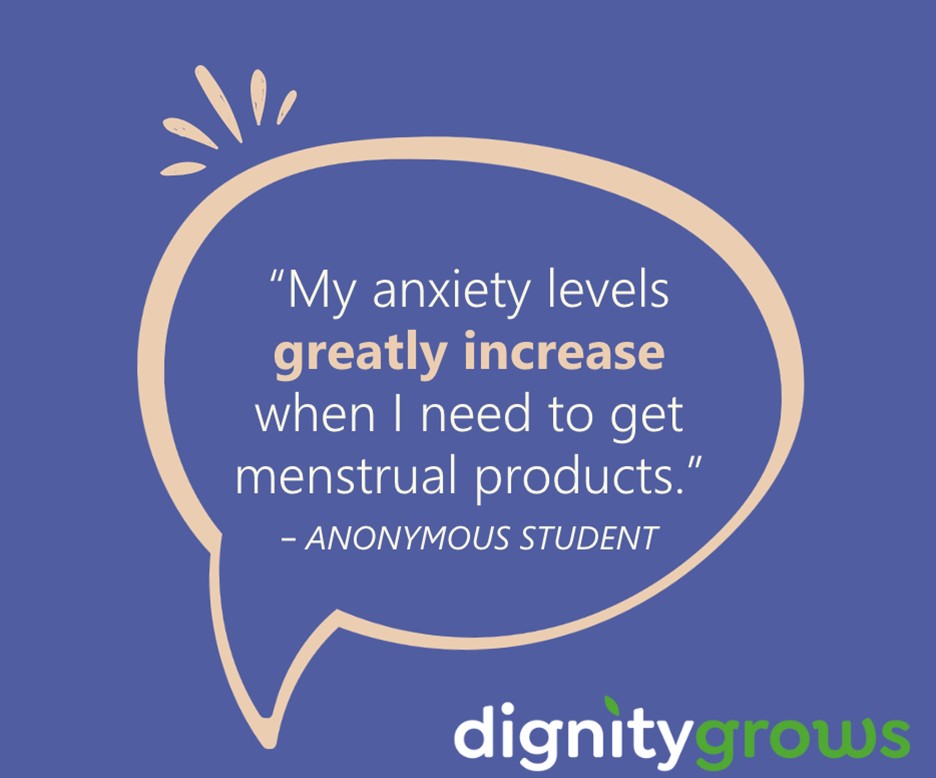Education is a fundamental right, and every student must have an equal opportunity to learn and thrive. However, an often overlooked yet unavoidable factor can significantly impact a student’s educational journey: menstrual cycles. To address this issue, we must explore how Period Poverty affects education for menstruators.

An intricate web of connections exists between Period Poverty and education, and these factors contribute to gender disparities. Enhancing menstrual equity is a vital component of fostering equal opportunities for all students.
What is “Chronic Absenteeism”?
Chronic absenteeism refers to a pattern of frequent, unexcused, or prolonged absences from school, which can have a detrimental impact on a student’s academic progress and overall educational experience.
Multiple interconnected factors may contribute to the challenge of chronic absenteeism, including transportation barriers, housing instability, and the students’ physical and mental health.
For students experiencing financial instability, housing instability, and issues with unreliable transportation, a monthly period can contribute to even more strife. For some students in these situations, they must choose between spending money on food or spending money on period products. Frequently, these students are forced to resort to unhygienic substitutes such as kitchen towels or skipping classes altogether to prevent any mishaps related to menstruation.

The Link Between Period Poverty and Gender Education Gaps
One of the primary ways in which Period Poverty contributes to gender education gaps is through chronic absenteeism. The consequence of menstruation-related absences is a significant disruption to students’ education and a potentially detrimental impact on their academic performance. Over time, this absence from school can lead to educational disparities that are difficult to bridge.
A lack of access to menstrual products not only affects attendance but can also lead to reduced classroom participation. Students who do manage to attend school despite Period Poverty often face the discomfort and anxiety associated with inadequate supplies. This can lead to diminished self-esteem, reduced classroom engagement, and a lack of focus on their studies. As a result, these students may not fully benefit from the educational opportunities available to them.
Addressing the link between Period Poverty and gender education gaps requires a multifaceted approach. Schools, policymakers, and communities need to come together to ensure that all students have access to affordable or free menstrual products. Additionally, education about menstrual health and destigmatizing menstruation is crucial to creating an inclusive learning environment where students can manage their periods without feeling ashamed or disadvantaged.

Support Systems for Students Facing Period Poverty
One of the key components of support systems for students facing Period Poverty is the provision of accessible period products in schools. By making these products readily available, schools help alleviate the financial burden that often leads to absenteeism and discomfort among menstruating students. This step not only ensures access to necessary supplies but also contributes to a more inclusive and equitable learning environment.
In addition to the provision of menstrual products, support systems should include educational initiatives that promote menstrual health awareness. It’s essential to break the stigma surrounding menstruation and encourage open conversations about it. Educators and peers can play a vital role in fostering an atmosphere where students can comfortably discuss their needs and seek assistance when necessary.
Community-based support programs are also instrumental in addressing Period Poverty. These programs may involve partnerships with local organizations and nonprofits, offering resources, such as menstrual product distribution centers, to serve not only students but also individuals and families experiencing financial hardships.
By providing access to period products, promoting menstrual health education, and fostering a supportive environment, educators and administrators can empower students to manage their menstrual needs with dignity and ensure that Period Poverty does not hinder their pursuit of academic success.
Dispelling Myths and Reducing Stigma
Menstruation is a natural process that has been historically surrounded by myths and stigma. These misconceptions and stereotypes can significantly impact school-age menstruators. The perpetuation of myths and stigmas can lead to embarrassment and shame among menstruating students, affecting their self-esteem and willingness to discuss their menstrual needs.
Comprehensive menstrual health education is crucial in addressing these challenges. Schools should provide accurate information about menstruation, empowering students to make informed decisions about their health and feel more comfortable discussing their periods.

Dispelling myths and reducing stigma is essential for creating a supportive and inclusive educational environment where students can openly address their menstrual needs and focus on their education, contributing to a more empowering educational experience for all.
Advancing Education Equality through Menstrual Equity
Menstrual equity is the notion that everyone should have access to affordable and safe menstrual products. It is not only a matter of social justice but also a powerful tool for advancing education equality.
Schools should implement policies that provide free menstrual products and create supportive environments where menstruators are not disadvantaged. Additionally, providing education about menstrual health and hygiene can help students understand their bodies and needs better, further contributing to educational equality.
By addressing Period Poverty, reducing stigma, and ensuring access to menstrual products and education, we can take significant steps toward creating an inclusive and equitable educational landscape.
Advancing menstrual equity is not just a matter of social justice; it’s an investment in a brighter, more equitable future for all students, regardless of their gender. Learn more about how Dignity Grows is advancing menstrual equity.
PFrequently Asked Questions
How does Period Poverty affect students?
Period poverty affects students by hindering their ability to access necessary menstrual hygiene products, leading to missed school days, decreased concentration, and embarrassment. Without proper supplies, students may resort to using inadequate substitutes or stay home altogether, affecting their academic performance and overall well-being. Moreover, the financial strain of purchasing products exacerbates the issue for low-income families, perpetuating a cycle of inequality and stigma surrounding menstruation.
Why should period products be free in schools?
Period products should be free in schools to ensure equitable access to menstrual hygiene for all students. Providing these products removes barriers to education caused by Period Poverty, promoting attendance and academic performance. It also helps destigmatize menstruation and fosters a supportive environment. By addressing this basic need, schools demonstrate their commitment to gender equality and student well-being, ultimately creating a more inclusive and empowering educational experience.
What can be done to increase menstrual equity in schools?
To increase menstrual equity in schools, provide free or affordable menstrual products, offer menstrual health education, create supportive environments, and work with local organizations and policymakers to address Period Poverty and reduce stigma.
